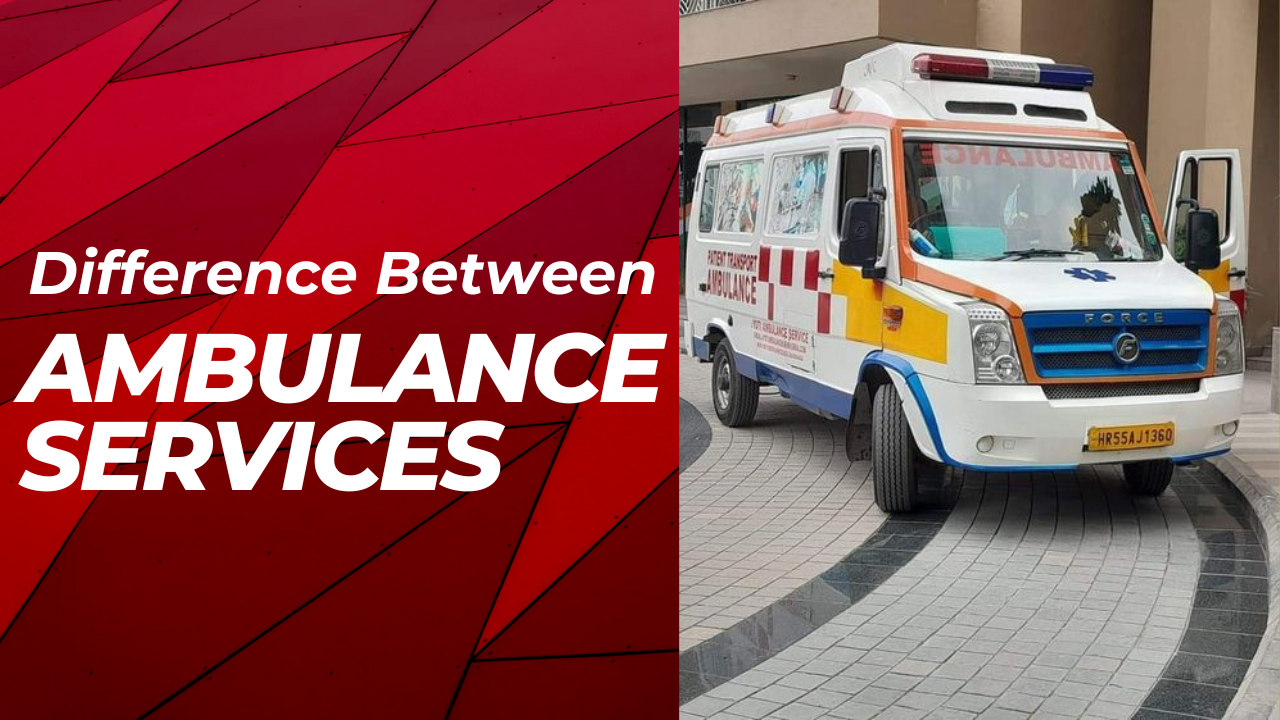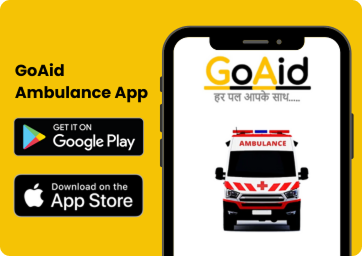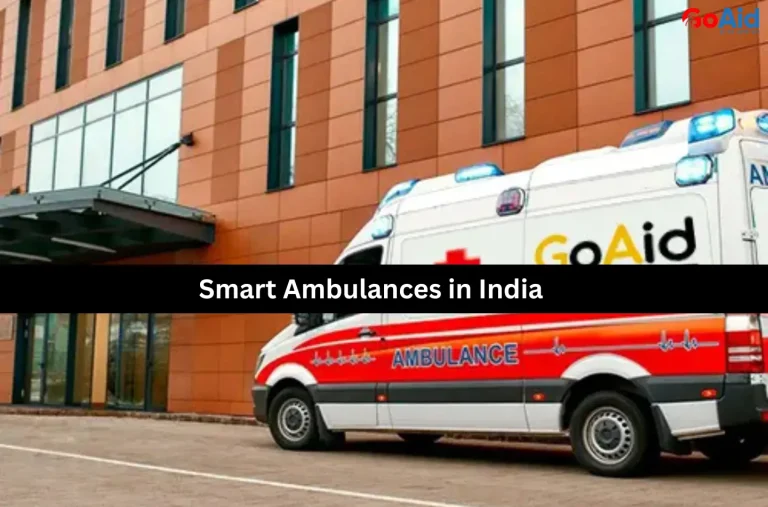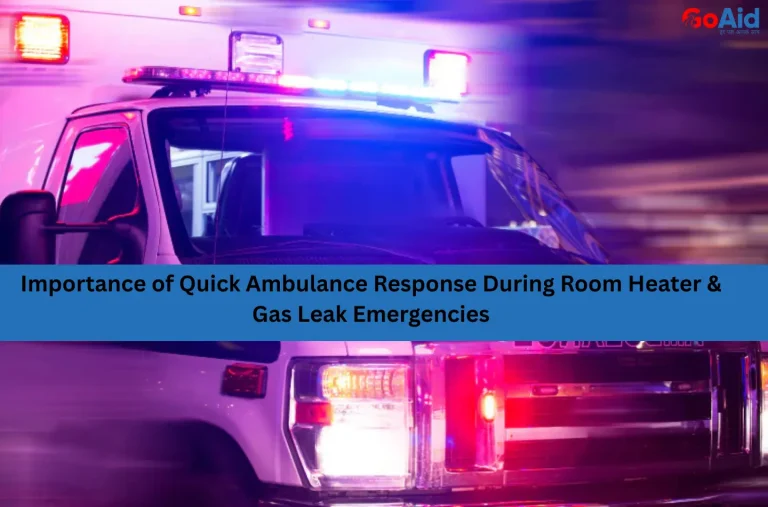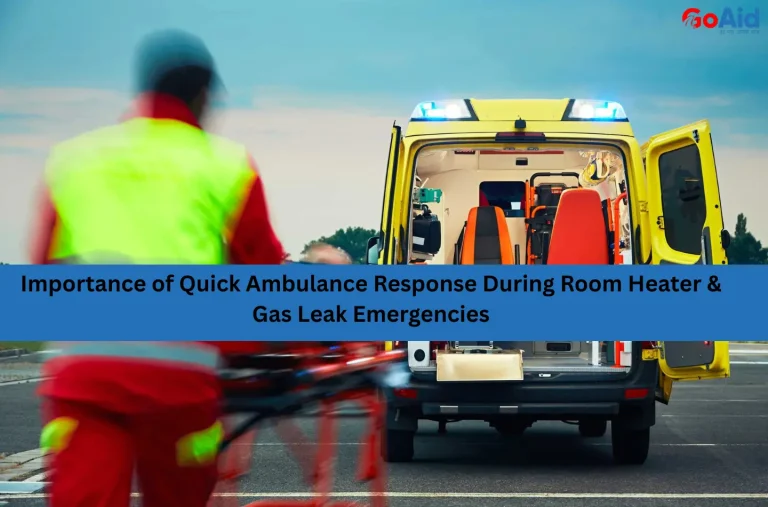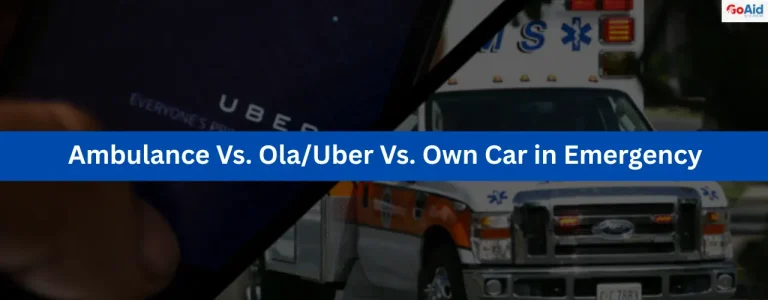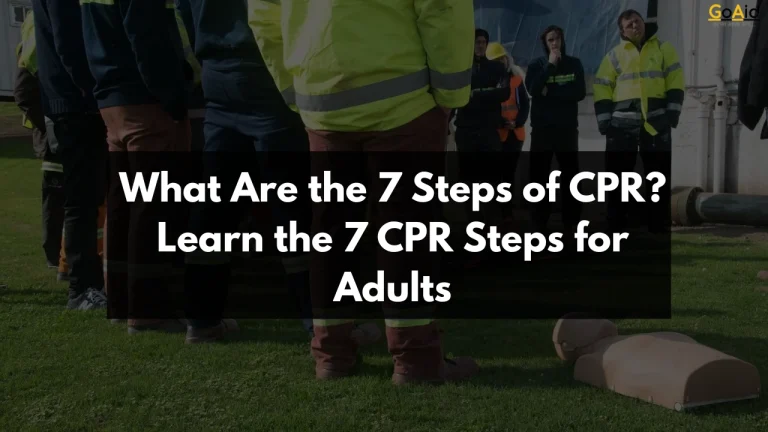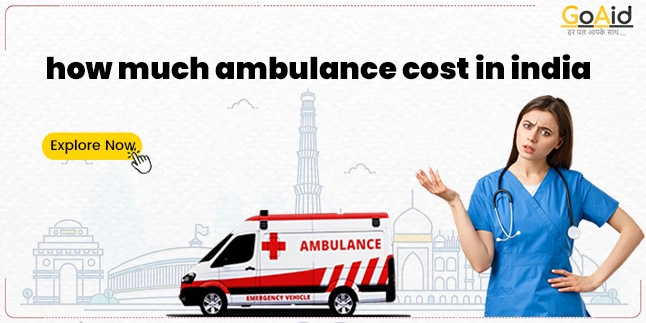If you want to know the difference between ambulance services, then before this, you have to be clear about the different types of ambulance services. Knowing about different types of ambulances provides us a base that which ambulances are comparable to others.
This is why, in this blog, we have provided you with complete details about the difference between ambulance services, and before that, we also have guided you with comprehensive information about all types of ambulance services in India. If you are also interested in knowing about the different types of ambulance services in India, the features of each type of ambulance, and the difference between all of them, then read our blog to the end.
So, letŌĆÖs start-
Different types of ambulance services in India
India’s healthcare system offers a diverse range of ambulance services to cater to various medical needs. These services are crucial for providing timely medical assistance and transportation to patients. Here is a comprehensive overview of the different types of ambulance services available in India:
1. Basic Life Support (BLS) Ambulance
In this type of ambulance service, BLS ambulances are essential for providing non-invasive pre-hospital care to patients. These ambulances are equipped with basic medical equipment such as oxygen cylinders, Automated External Defibrillators (AEDs), and essential medical supplies like bandages and splints.
Trained paramedics or emergency medical technicians typically staff BLS ambulances. They are mainly used for transporting non-critical patients who need medical monitoring during transit, ensuring they receive appropriate care until they reach a healthcare facility.
Features:
- Oxygen cylinders
- Automated External Defibrillators (AEDs)
- Basic medical supplies (bandages, splints)
- Trained paramedics or emergency medical technicians
- Non-invasive medical monitoring equipment
Use Cases:
- Non-critical patient transport
- Transfers between hospitals
- Minor injury assistance
2. Advanced Life Support (ALS) Ambulance
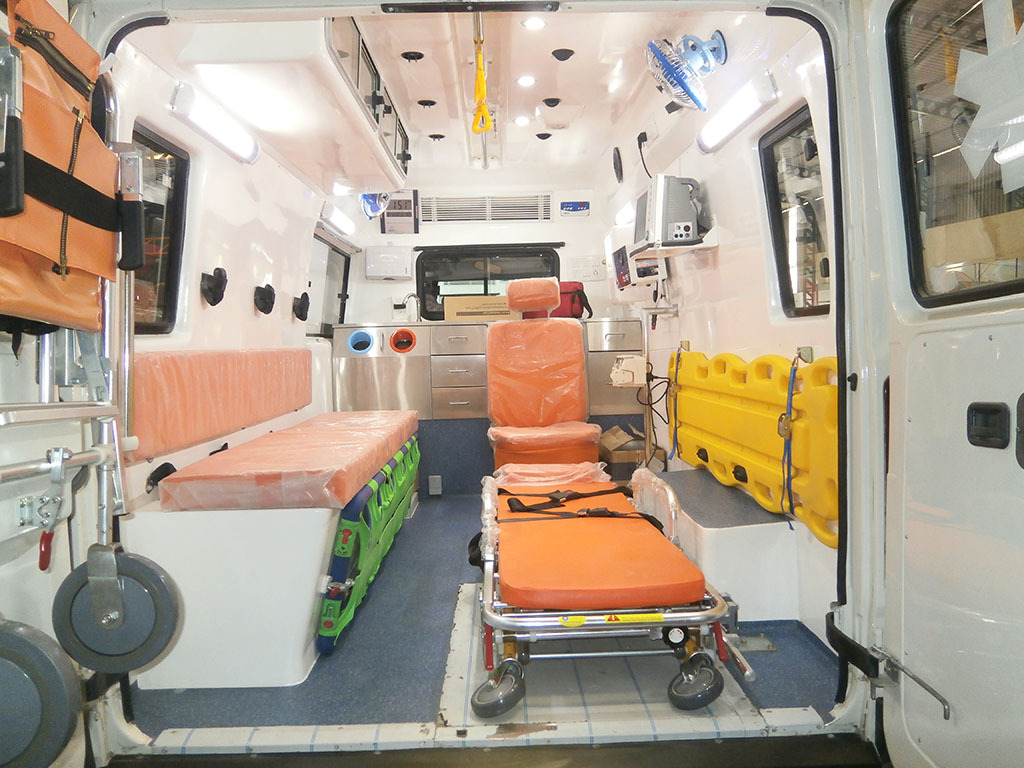
In this type of ambulance service, ALS ambulances are designed for critical patient care and emergencies. They come equipped with advanced medical equipment, including cardiac monitors, defibrillators, IV equipment, and advanced airway management tools.
Medications for emergencies are also available. Staffed by highly trained paramedics, nurses, and sometimes doctors, ALS ambulances can perform invasive procedures and intensive monitoring, making them suitable for severe medical conditions like heart attacks and strokes, ensuring patients receive timely and advanced medical intervention.
Features:
- Cardiac monitors and defibrillators
- Intravenous (IV) equipment
- Advanced airway management tools
- Medications for emergency use
- Trained paramedics, nurses, and sometimes doctors
Use Cases:
- Critical patient transport
- Emergency response to severe medical conditions (heart attacks, strokes, etc.)
- High-risk patient transfers
Read More: Introduction to the Difference between BLS Ambulance and ALS Ambulance
3. Normal Ambulance Services
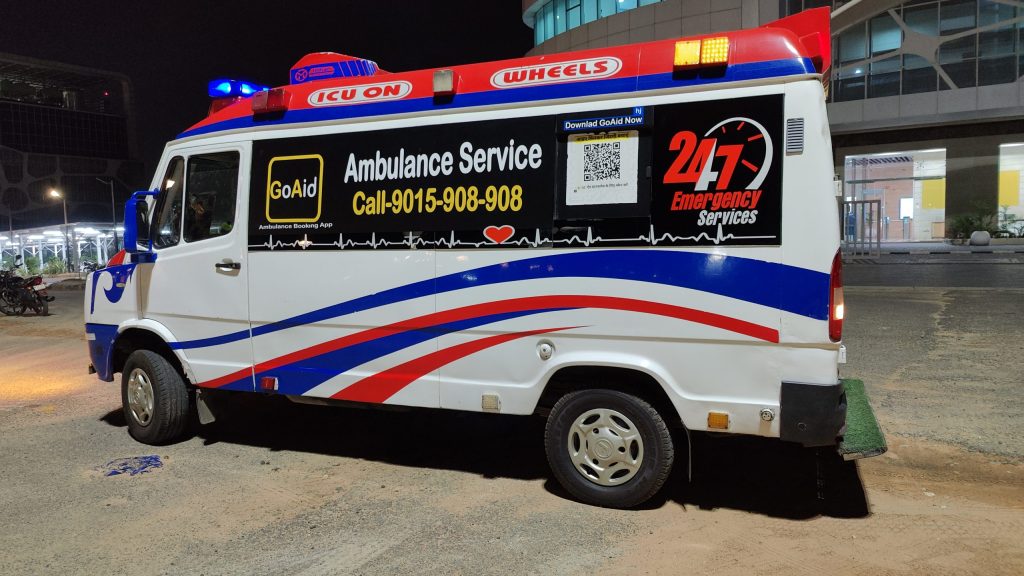
In this type of ambulance service, Normal ambulance services cater to non-emergency medical transportation needs. These ambulances are used for routine patient transfers, such as taking patients to and from medical appointments, discharges from hospitals, and non-urgent medical visits.
They are equipped with basic medical supplies and comfortable seating or a stretcher to ensure the patient’s safety and comfort during transit. These ambulances are not meant for emergencies but provide a reliable means of transport for those requiring medical supervision.
Features:
- Basic medical equipment
- Comfortable seating and stretcher
- Non-emergency patient transport capabilities
- Standard safety features
- Trained ambulance drivers
Use Cases:
- Routine hospital visits
- Discharge from hospital to home
- Non-emergency medical appointments
4. Oxygen Ambulance Services

In this type of ambulance service, Oxygen ambulances are specialized for patients needing respiratory support during transportation. These ambulances are equipped with oxygen cylinders and delivery systems to ensure continuous oxygen supply.
They are crucial for patients with chronic respiratory issues, post-surgical patients who need oxygen support, and individuals experiencing acute respiratory distress. The availability of supplemental oxygen in these ambulances helps stabilize patients’ conditions and ensures their safe transfer to healthcare facilities.
Features:
- Oxygen cylinders and delivery systems
- Basic life support equipment
- Trained medical staff
- Monitoring devices for respiratory conditions
- Comfortable and safe patient transport setup
Use Cases:
- Patients with chronic respiratory issues
- Post-surgical patients needing oxygen support
- Transport of patients with acute respiratory distress
5. ICU Ventilator Ambulance Services
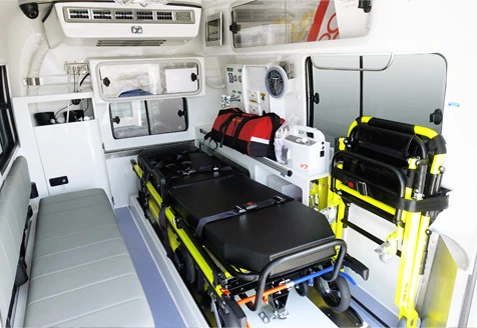
In this type of ambulance service, ICU ventilator ambulances function as mobile intensive care units. They are equipped with mechanical ventilators, advanced monitoring systems, and a full range of ICU medications and equipment. These ambulances are staffed by critical care specialists, including doctors and nurses trained in intensive care.
They are used for transporting critically ill patients who require continuous intensive care and monitoring, making them ideal for high-risk inter-hospital transfers and emergencies that need immediate and advanced medical intervention.
Features:
- Mechanical ventilators
- Advanced patient monitoring systems
- Full range of ICU medications and equipment
- Critical care specialists on board
- Invasive procedure capability
Use Cases:
- Transport of critically ill patients
- Inter-hospital transfers requiring intensive care
- Emergencies needing immediate ICU care
6. Dead Body Mortuary Van
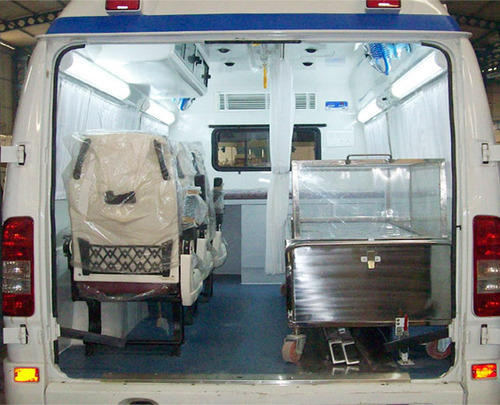
In this type of ambulance service, Dead body mortuary vans are designed for the dignified and hygienic transportation of deceased individuals. These vans are equipped with refrigeration systems to preserve the body and spacious interiors to facilitate easy handling.
They ensure the respectful transport of the deceased from hospitals to homes, mortuaries, or cremation/burial sites. The primary focus is on maintaining hygiene and dignity during the transit process, providing families with a reliable service during a sensitive time.
Features:
- Refrigeration systems for body preservation
- Spacious interiors for easy handling
- Hygienic and sanitized interiors
- Secured transport setup
- Trained personnel for respectful handling
Use Cases:
- Transport of deceased from hospitals to homes
- Transfers between mortuaries and cremation/burial sites
7. Dead Body Freezer Box
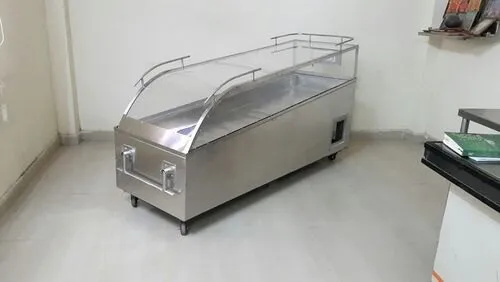
In this type of ambulance service, Dead body freezer boxes are portable units used to preserve deceased individuals at low temperatures. These boxes are essential for preventing decomposition during transportation or when there is a delay in performing the final rites.
Equipped with temperature control systems, they ensure the body remains preserved. Their portable and compact design allows for easy transport and temporary preservation at home or other locations until the final arrangements are made.
Features:
- Temperature control systems
- Portable and compact design
- Hygienic interiors
- Easy to transport
- Reliable preservation for extended periods
Use Cases:
- Temporary preservation at home before final rites
- Transport over long distances
8. Dead Body Freezer Box on Rent
This type of ambulance service, service offers freezer boxes or mortuary vans on a rental basis for preserving and transporting deceased individuals. The service ensures that the body remains in good condition until the final rites are performed.
The rental periods are flexible, catering to the specific needs of the families. This option is particularly useful for families needing temporary preservation solutions or when transportation over extended periods or distances is required.
Features:
- Rentable freezer boxes and mortuary vans
- Flexible rental periods
- Preserved conditions for the deceased
- Temperature control for body preservation
- Secure and respectful transport options
Use Cases:
- Families needing temporary preservation solutions
- Situations requiring transportation over extended periods
Also Read: Dead Body Freezer Box On Rent
9. Surgery Ambulance Services
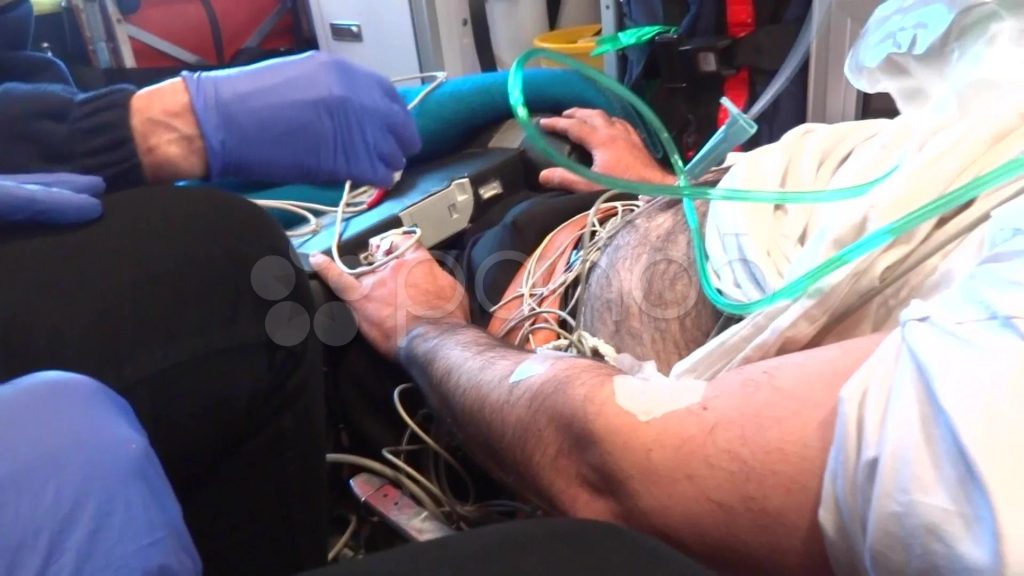
In this type of ambulance service, Surgery ambulances are equipped to perform minor surgical procedures during transit. They are staffed by surgeons and equipped with portable surgical instruments and sterile environments to ensure the safety and hygiene of the procedures.
These ambulances are used in emergencies where immediate surgical intervention is required, making it possible to perform critical surgeries en route to the hospital, thus saving valuable time and potentially lives in urgent situations.
Features:
- Portable surgical equipment
- Sterile environments
- Trained surgical staff
- Emergency surgical intervention capabilities
- Advanced monitoring and life support systems
Use Cases:
- Emergency surgeries en route to the hospital
- Minor procedures that cannot wait until arrival at a medical facility
10. Event Ambulance Services
In this type of ambulance service, Event ambulances provide immediate medical assistance at large gatherings such as concerts, sports events, and festivals. These ambulances are equipped with both basic and advanced life support equipment to handle medical emergencies on-site.┬Ā
Staffed by trained medical personnel, event ambulances offer quick response capabilities to ensure the safety and well-being of attendees. They are strategically stationed to provide rapid care and, if necessary, transport patients to nearby hospitals for further treatment.
Features:
- Basic and advanced life support equipment
- Trained medical staff
- Quick response capabilities
- Strategic stationing at events
- Immediate transport to nearby hospitals if needed
Use Cases:
- Medical emergencies at large public gatherings
- On-site medical care during events
- Immediate transport to nearby hospitals if needed
11. Hospital Ambulance Services
Hospital ambulances are operated by healthcare facilities to provide patient transport services. These ambulances are used for transferring patients between different medical facilities or from the hospital to the patient’s home.
They are equipped according to the hospital’s standards and are staffed by medical personnel trained in the hospital’s protocols. Hospital ambulances ensure that patients receive consistent and reliable care during transport, facilitating seamless transitions between various points of medical care.
Features:
- Equipped according to hospital standards
- Trained hospital medical personnel
- Reliable patient transport
- Medical monitoring during transit
- Consistent care protocols from hospital to hospital
Use Cases:
- Inter-hospital patient transfers
- Discharge and home transport services
- Emergency response services associated with the hospital
Also Read: Air Ambulance Service From Dubai to India
Difference between Ambulance services
In India, There are so many ambulances, but we have added the comparison between all major ambulances asked by our readers:
Difference Between ALS & BLS Ambulance Services
This is the complete Difference Between ALS & BLS Ambulance Services:
| Attribute | ALS (Advanced Life Support) | BLS (Basic Life Support) |
| Medical Equipment | Advanced (cardiac monitors, defibrillators, IVs) | Basic (oxygen cylinders, AEDs, splints) |
| Staff | Highly trained (paramedics, nurses, sometimes doctors) | Trained paramedics or emergency medical technicians |
| Procedures | Invasive procedures | Non-invasive procedures |
| Medications | Includes emergency medications | Limited medications |
| Use Cases | Critical patients (heart attacks, strokes) | Non-critical patients need monitoring |
| Main Objective | Provide intensive and advanced medical care | Provide basic medical monitoring and support |
| When to Book | For severe medical emergencies | For non-critical situations needing basic care |
| How to Book | Through hospital emergency services or ambulance providers | Through hospital or local ambulance services |
Difference Between ALS and Normal Ambulance Services
This is the complete Difference Between ALS and Normal Ambulance Services:
| Attribute | ALS (Advanced Life Support) | Normal Ambulance Services |
| Medical Equipment | Advanced (cardiac monitors, defibrillators, IVs) | Basic medical equipment |
| Staff | Highly trained (paramedics, nurses, sometimes doctors) | Trained ambulance drivers |
| Procedures | Invasive procedures | None |
| Medications | Includes emergency medications | Typically no medications |
| Use Cases | Critical patients (heart attacks, strokes) | Routine patient transport |
| Main Objective | Provide intensive and advanced medical care | Transport patients without the need for medical intervention |
| When to Book | For severe medical emergencies | For routine, non-emergency transport |
| How to Book | Through hospital emergency services or ambulance providers | Through hospital or local ambulance services |
Difference Between ICU Ventilator and Oxygen Ambulance Services
This is the complete Difference Between ICU Ventilator Ambulance and Oxygen Ambulance Services:
| Attribute | ICU Ventilator Ambulance | Oxygen Ambulance |
| Medical Equipment | Mechanical ventilators, advanced monitors | Oxygen cylinders and delivery systems |
| Staff | Critical care specialists | Trained medical staff |
| Procedures | Capable of intensive care procedures | Oxygen administration and basic monitoring |
| Medications | Full range of ICU medications | Basic medications related to respiratory support |
| Use Cases | Critically ill patients needing continuous intensive care | Patients needing respiratory support during transport |
| Main Objective | Provide intensive and continuous critical care | Provide respiratory support |
| When to Book | For critically ill patients requiring intensive care | For patients with respiratory issues needing oxygen support |
| How to Book | Through hospital emergency services or ambulance providers | Through hospital or local ambulance services |
Difference Between Oxygen and BLS Ambulance Services
This is the complete Difference Between Oxygen and BLS Ambulance Services:
| Attribute | Oxygen Ambulance | BLS (Basic Life Support) |
| Medical Equipment | Oxygen cylinders and delivery systems | Basic (oxygen cylinders, AEDs, splints) |
| Staff | Trained medical staff | Trained paramedics or emergency medical technicians |
| Procedures | Oxygen administration | Non-invasive procedures |
| Medications | Basic medications related to respiratory support | Limited medications |
| Use Cases | Patients needing respiratory support during transport | Non-critical patients need monitoring |
| Main Objective | Provide respiratory support | Provide basic medical monitoring and support |
| When to Book | For patients with respiratory issues needing oxygen support | For non-critical situations needing basic care |
| How to Book | Through hospital or local ambulance services | Through hospital or local ambulance services |
Difference Between Mortuary Van and Dead Body Freezer Box
This is the complete Difference Between Mortuary Van and Dead Body Freezer Box ambulance services:
| Attribute | Dead Body Mortuary Van | Dead Body Freezer Box |
| Medical Equipment | Refrigeration systems for body preservation | Temperature control systems |
| Staff | Trained personnel for respectful handling | Not applicable |
| Procedures | Handling and transport of deceased individuals | Preservation of the deceased at low temperatures |
| Medications | Not applicable | Not applicable |
| Use Cases | Transport of deceased from hospitals to homes or cremation/burial sites | Preventing decomposition of deceased during transport or delay of rites |
| Main Objective | Respectful and hygienic transport of the deceased | Preserve deceased individuals at low temperatures |
| When to Book | For transporting deceased individuals | For preserving and transporting deceased individuals |
| How to Book | Through mortuary services or funeral homes | Through mortuary services or funeral homes |
Conclusion for Difference between Ambulance Services
In Conclusion, understanding the differences between various ambulance services in India is crucial for making informed decisions during medical emergencies and non-emergency situations. Basic Life Support (BLS) and Advanced Life Support (ALS) ambulances cater to different levels of medical needs, with ALS providing more intensive care.
Normal ambulances serve routine patient transport, while specialized services like ICU ventilators and oxygen ambulances address specific medical conditions. Additionally, services for deceased individuals, such as mortuary vans and dead body freezer boxes, ensure respectful and hygienic handling. Each type of service has unique features, objectives, and booking processes tailored to specific scenarios.
Whether dealing with critical patient care, routine transport, or handling deceased individuals, selecting the appropriate service can significantly impact the outcome. In the end, If you have any questions or relatable queries related to the difference between ambulance services, then ask that in the comment box.
Book Ambulance: GoAid Ambulance Service
FAQs related to the Difference between ambulance services
BLS ambulances provide basic non-invasive medical care, while ALS ambulances offer advanced life support with more sophisticated equipment and capabilities for invasive procedures.
ALS ambulances should be booked for severe medical emergencies, such as heart attacks, strokes, or situations requiring advanced medical intervention and monitoring.
Normal ambulance services are suitable for routine patient transport, such as hospital discharges or non-emergency medical appointments.
ICU ventilator ambulances are equipped with mechanical ventilators, advanced monitoring systems, and ICU medications, and are staffed by critical care specialists.
Oxygen ambulances are specifically equipped with oxygen cylinders and delivery systems for patients needing respiratory support, while BLS ambulances provide basic medical monitoring and support.
Mortuary vans are used for the dignified transport of deceased individuals, while dead body freezer boxes preserve bodies at low temperatures to prevent decomposition.
Renting a dead body freezer box is suitable when temporary preservation of the deceased is needed, such as delays in performing final rites or transporting over longer distances.
Event ambulances are stationed at large gatherings to provide immediate medical assistance, while hospital ambulances focus on patient transport between medical facilities or from hospitals to homes.
Surgery ambulances are equipped for minor surgical procedures en route to hospitals, providing critical care before patients reach surgical facilities.
ALS ambulances can be booked through hospital emergency services or local ambulance providers, ensuring prompt response and specialized medical care during critical emergencies.
Oxygen ambulances are equipped to provide respiratory support for patients with acute respiratory distress, chronic respiratory conditions, or those requiring oxygen therapy during transport.
An ICU ventilator ambulance is preferred for transporting critically ill patients requiring continuous intensive care, including mechanical ventilation and advanced medical monitoring.

